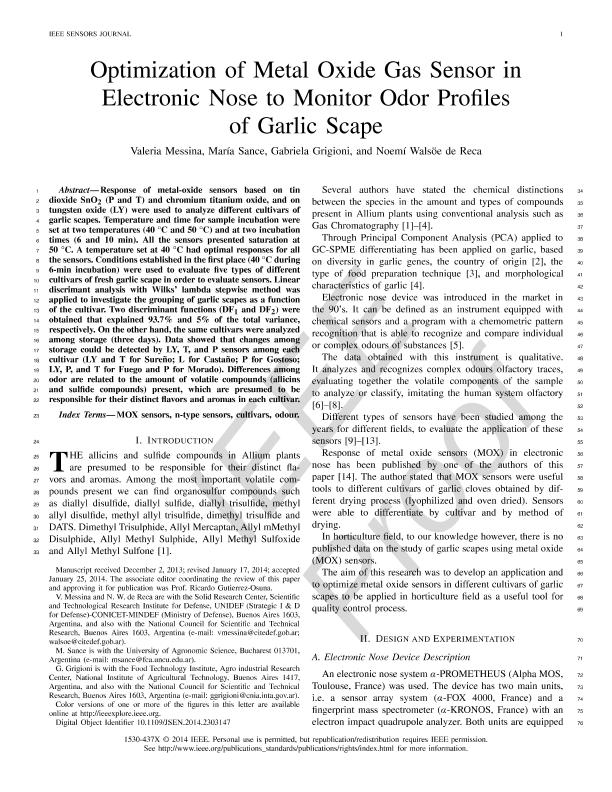Artículo
Optimization of metal oxide gas sensor in electronic nose to monitor odor profiles of garlic scape
Fecha de publicación:
01/2014
Editorial:
Institute of Electrical and Electronics Engineers
Revista:
IEEE Sensors Journal
ISSN:
1530-437X
e-ISSN:
1558-1748
Idioma:
Inglés
Tipo de recurso:
Artículo publicado
Clasificación temática:
Resumen
Response of metal-oxide sensors based on tin dioxide SnO2 (P and T) and chromium titanium oxide, and on tungsten oxide (LY) were used to analyze different cultivars of garlic scapes. Temperature and time for sample incubation were set at two temperatures (40 °C and 50 °C) and at two incubation times (6 and 10 min). All the sensors presented saturation at 50 °C. A temperature set at 40 °C had optimal responses for all the sensors. Conditions established in the first place (40 °C during 6-min incubation) were used to evaluate five types of different cultivars of fresh garlic scape in order to evaluate sensors. Linear discrimant analysis with Wilks' lambda stepwise method was applied to investigate the grouping of garlic scapes as a function of the ultivar. Two discriminant functions (DF1 and DF2) were obtained that explained 93.7% and 5% of the total variance, respectively. On the other hand, the same cultivars were analyzed among storage (three days). Data showed that changes among storage could be detected by LY, T, and P sensors among each cultivar (LY and T for Sureño; L for Castaño; P for Gostoso; LY, P, and T for Fuego and P for Morado). Differences among odor are related to the amount of volatile compounds (allicins and sulfide compounds) present, which are presumed to be responsible for their distinct flavors and aromas in each cultivar.
Palabras clave:
Cultivars
,
Mox Sensors
,
N-Type Sensors
,
Odour
Archivos asociados
Licencia
Identificadores
Colecciones
Articulos(SEDE CENTRAL)
Articulos de SEDE CENTRAL
Articulos de SEDE CENTRAL
Articulos(UNIDEF)
Articulos de UNIDAD DE INVESTIGACION Y DESARROLLO ESTRATEGICOS PARA LA DEFENSA
Articulos de UNIDAD DE INVESTIGACION Y DESARROLLO ESTRATEGICOS PARA LA DEFENSA
Citación
Messina, Valeria Marisa; Sance, Maria Mirta; Grigioni, Gabriela Maria; Walsoe, Noemi Elizabeth; Optimization of metal oxide gas sensor in electronic nose to monitor odor profiles of garlic scape; Institute of Electrical and Electronics Engineers; IEEE Sensors Journal; 14; 6; 1-2014; 1765-1769
Compartir
Altmétricas




